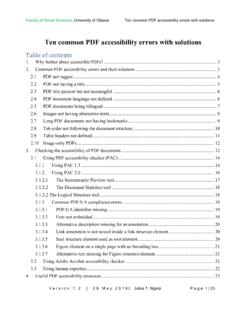Transcription of SECOND LANGUAGE LEARNING ERRORS THEIR TYPES, …
1 SECOND LANGUAGE LEARNING ERRORS THEIR TYPES, CAUSES, AND TREATMENT Hanna Y. Touchie Abstract Recent research in applied linguistics emphasizes the significance of learners' ERRORS in SECOND LANGUAGE learn-ing. In this article, major types of ERRORS in SECOND LANGUAGE LEARNING are first briefly mentioned. This is followed by tracing the sources of SECOND LANGUAGE LEARNING ERRORS to both interlingual and intralingual or developmental factors. While interlingual ERRORS are caused mainly by mother tongue interference, intra-'lingual or developmental ERRORS originate in the follow-ing factors: simplification, overgeneralization, hyper-correction, faulty teaching, fossilization, avoidance, inadequate LEARNING , and false concepts hypothesized.
2 The article concludes with some general guidelines for teachers in correcting ERRORS in SECOND LANGUAGE LEARNING . LANGUAGE LEARNING , like any kind of human LEARNING , involves committing ERRORS . In the past, LANGUAGE teachers considered ERRORS committed by THEIR stud en ts as something undesirable which they diligently sought to prevent from occurring. During the past fifteen years, however, researchers in the field of applied linguistics came to view ERRORS as evidence for a creative process in LANGUAGE LEARNING in which learners employ hypothesis testin~ and various strategies in LEARNING a SECOND Dr Hanna Touchie received his from the University of Texas at' Austin.
3 He is now Assistant Professor of Linguistics and ESL at the An-Najah National University, Nablus in the West Bank, via Israel. He was a presenter at JALT '85. 75 JALT Journal, Volume 8, No. I (1986) LANGUAGE . Far from being a nuisance to be eradicated, ERRORS are, as Selinker (1969) indicates, significant in three respects: (1) ERRORS are important for the LANGUAGE teacher because they indicate the learner's progress in LANGUAGE LEARNING ; (2) ERRORS are also important for the LANGUAGE researcher as they provide insights into how LANGUAGE is learnt; and (3) finally, ERRORS are significant to the LANGUAGE learner himself/herself as he/she gets involved in hypothesis testing.
4 In this article, I am going to discuss briefly the types of ERRORS made by SECOND LANGUAGE learners, the causes of these ERRORS , and finally how teachers should correct them. Types of ERRORS Researchers in the field of applied linguistics usually dis-tmguish between two types of ERRORS : performance ERRORS and competence ERRORS . Performance ERRORS are those ERRORS made by learners when they are tired or hurried. Normally, this type of error is not serious and can be overcome with little effort by the learner. Competence ERRORS , on the other hand, are more serious than performance ERRORS since competence ERRORS reflect inadequate LEARNING .
5 In this connection, it is important to note that researchers (cf. Gefen 1979) distinguish between mistakes which are lapses in performance and ERRORS which reflect inadequate competence. Other researchers (cf. Burt and Kiparsky 1974) distinguish between local and global ERRORS . Local ERRORS do not hinder communication and understanding the meaning of an utter-ance. Global ERRORS , on'the other hand, are more serious than local ERRORS because global ERRORS interfere with communica-tion and disrupt the meaning of utterances. Local ERRORS involve noun and verb inflections, and the use of articles, prepositions, and auxiliaries.
6 Global ERRORS , for example, in-volve wrong word order in a sentence. Finally, LANGUAGE LEARNING ERRORS involve all LANGUAGE com-76 SECOND LANGUAGE LEARNING ERRORS ponents: the phonological, the morphological, the lexical, and the syntactic. An example of a phonological error is the hick of distinction between the phoneme /p / and the phon-eme /b/ among Arab ESL learners; so we hear them saying pird and brison, for example, instead of bird and prison. An example of a morphological error is the production of such ERRORS as womans, sheeps, and furnitures. A lexical error involves inappropriate direct translation from the learner's native LANGUAGE or the use of wrong lexical items in the SECOND LANGUAGE .
7 Examples of lexical ERRORS are: This is the home that my father built, and The clock is now ten. Finally, examples of syntactic ERRORS are ERRORS in word order, subject-verb agreement, and the use of the resumptive pronoun in English relative clauses produced by Arab ESL learners as illustrated in: The boy that I saw him is called Ali. Causes of ERRORS There are mainly two major sources of ERRORS in SECOND LANGUAGE LEARNING . The first source is interference from the native LANGUAGE while the SECOND source can be attributed to intralingual and developmental factors. The native LANGUAGE of learners plays a significant role in LEARNING a SECOND LANGUAGE .
8 ERRORS due to the influence of the native LANGUAGE are called interlingual ERRORS . Interlingual ERRORS are also called transfer or interference ERRORS . The view that the native LANGUAGE plays a mostly negative role was emphasized as early as the forties and tile fifties by Fries (1945) and Lado (1957). Althougll recently researchers tend to minimize interlingual ERRORS and emphasize intralingual and developmental ~rrors (cf. Dulay and Burt 1974), negative transfer or interference is still acknowledged as an inlportant factor in SECOND LANGUAGE LEARNING (cf. J ordens 1977; Keller-man 1979; Touchie 1983).
9 Intralingual and developmental ERRORS are due to the diffi-culty of the SECOND /target LANGUAGE . Intralingual and develop-mental factors include the following: 77 JALT JournaL Volume 8, No. I (1986) 1. Simplification: Learners often choose simple forms and constructions instead of more complex ones. An example of simplification might involve the use of simple present instead of the present perfect continuous. 2. Overgeneralization: This is the use of one form or con-struction in one context and extending its application to other contexts where it should not apply. Examples of overgeneralization include the use of corned and goed as the past tense forms of corne and go and the omission of the third person singular s under the heavy pressure of all other endless forms as in I,e go.
10 It should be noted that simplification and overgeneraliza-tion are used by learners in order to reduce THEIR linguistic burden. 3. Hypercorrection: Sometimes the zealous efforts of teachers in correcting THEIR students' ERRORS induce the students to make ERRORS in otherwise correct forms. Stenson (1978) calls this type of error "induced ERRORS ." For example, the teacher's insistence that Arab ESL learners produce the phoneme IpI correctly prompts them to always produce IpI where the phoneme Ibl is required. Thus Arab ESL learners say piTd and pattie instead of bird and battle. 4. Faulty teaching: Sometimes it happens that learners' ERRORS are teacher-induced ones, , caused by the teacher, teach-ing materials, or the order of presentation.







